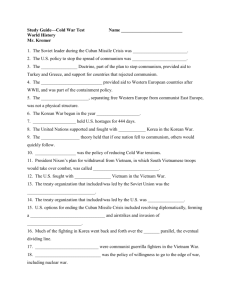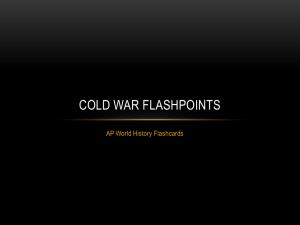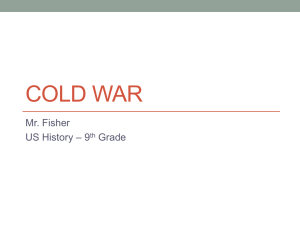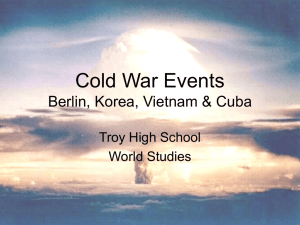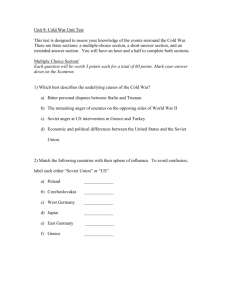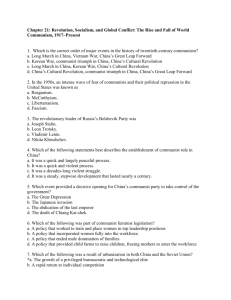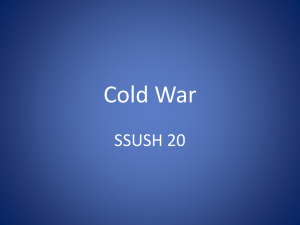8Blue Cold War Proxy War
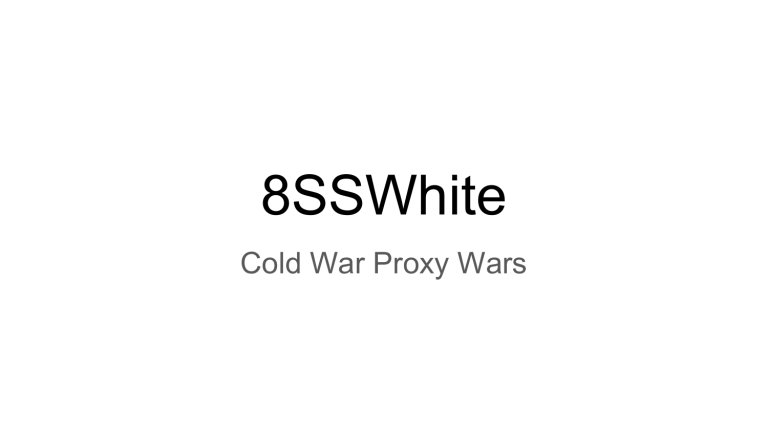
8SSWhite
Cold War Proxy Wars
South
Vietnam
China
USA
The Vietnam War
Tristan, Thomas, Grant, and Liam
Soviet
Union flag
North
Vietnam
Vocabulary
Geneva Accords - Divided Vietnam at the 17th parallel, planned free elections that never occurred
Guerilla tactics - Smaller groups like armed civilians ambush, raid, and hit and run tactics.
Communism - A political theory where everyone's work depends on people's skills and everyone get paid equal.
Domino Theory- The idea that if one country fell to communism, more countries would also fall (a row of dominoes).
Ho Chi Minh Trail-a series of trails that ran through Laos and Cambodia that helped
North Vietnam get troops, supplies, and food into South Vietnam
Background
Vietnam was occupied by
Japan during
WW2.
The French tried to recolonize
Vietnam.
North and
South
Vietnam
Vietnam fell into civil war, known as the Vietnam
War.
The French were defeated by the
Vietnamese.
After the Geneva accord, Vietnam was divided over the 17th parallel.
Causes and Effects
North Vietnam not happy with the
Geneva Accords
South Vietnam prevents elections
South
Vietnam punished communists
Vietnam
War
Vietnam became a communist nation
T he U.S. became politically embarrassed
Key Characters
Ho Chi Minh-leader of North Vietnam
Lyndon B Johnson Ngo Dihn Diem Ho Chi Minh
Lyndon B. Johnson-committed troops, considered to be the president who started US involvement in the war
John F. Kennedy-president who sent military advisors to South Vietnam
Richard Nixon-president who withdrew troops and ended the war
John F.
Kennedy
Ngo Dihn Diem-leader of South Vietnam
Richard
Nixon
The War
The Soviet
Union
China
North
Vietnam
VS
United
States
South
Vietnam
- The US send thousands of troops to aid South Vietnam
- China and the Soviet Union provided military supplies and money
- North Vietnamese troops used guerilla tactics to defeat better trained, armed, and supplied US troops
- The war expanded into Laos and Cambodia as the US attempted to disrupt communist supply lines
- Many civilians were killed and they lost their homes
- The US withdrew in 1974, and South Vietnam fell soon after
2 Big Events
The My Lai Massacre- The killing of 300 to 500 unarmed civilians in South Vietnam on March 16, 1968.
The Tet Offensive- One of the largest attacks in the Vietnam War, starting January 30, 1968, starting the Vietnam War’s most deadly battles after.
The Tet
Offensive
Video: Crash Course
8:40-10:04
Conclusion
The loss of the Vietnam war brought political embarrassment to the United States. It also divided citizens on the homefront dramatically, who had many different opinions, both political and social, like being against the war or supporting the war. The loss in Vietnam showed the US the danger of fighting in regional wars.
Today, Vietnam is still communist.
A picture of two hippies celebrating the end of the war
Citations
Google Images. Google, n.d. Web. 17 Sept. 2015.
"Cold War Proxy Wars." Modern World History. Maryland State Department of
Education, n.d. Web. 17 Sept. 2015.
SparkNotes . SparkNotes, n.d. Web. 17 Sept. 2015. < http://www.sparknotes.
com/history/american/vietnamwar/terms.html
>.
"The Vietnam War." BBC Bitesize . BBC, n.d. Web. 17 Sept. 2015. < http://www.bbc.co.
uk/education/guides/zv7bkqt/revision/2 >.
Citations
Vietnam War / Tet Offensive / US Marines. Photograph. Encyclopædia Britannica ImageQuest. Web.
18 Sep 2015.
"Ho Chi Minh Trail." The History Learning SIte. N.p., n.d. Web. 18 Sept. 2015. <http://www.
historylearningsite.co.uk/vietnam-war/ho-chi-minh-trail/>.
A map of North and South Korea at the time of the Cold War
Korean War
By: Ian, Nate, Ben, and Wyatt
Korean War Players
One side in the war was......
● South Korea- Syngman Rhee
● United Nations (mainly US)- Douglas MacArthur (US)
The other side was.......
● Soviet Union- Joseph Stalin
● China- Mao Zedong
● North Korea- Kim Il Sung
USSR
Motives of the Superpowers
United States China
The Soviets wanted communism to spread to all countries, including Korea.
The United States claimed to be protecting Korea with “Police Action.”
In reality they were trying to stop the spread of communism.
China wanted to stop the
US from stopping the
Soviets.
Key Dates of the War
● 1945- Korea divided at 38th parallel
● 1945- Potsdam Conference
● The Potsdam conference was the last meeting of the Big Three (Stalin,
Truman, and Churchill) after World War II when they discussed things like reparations, war criminals, and land boundaries
● 1950- North Korea invades South Korea, starting the war
● 1950-1953- The South pushes back the North and continues to advance with the help of the UN
● 1950-China invades Korea and pushes South Koreans back
● 1953- The war unofficially ends
The US, USSR, and
China began to compete for the
Korean government.
North Korea invades South
Korea on June 25,
1950.
The war escalates with the use of destructive weapons and military technology.
Flow Map
Korea shared a border with China, making
Chinese invasion a dangerous possibility.
The countries compromised by splitting Korea at the 38th parallel, which they decided at the Potsdam Conference.
(See Definition)
This decision was made without input from Korean officials.
The UN immediately passes a resolution condemning the invasion.
The UN forces drive communists north, but troops keep fighting in hope to make North Korea surrender completely.
The UN allows the use of troops to remove the
North Korean troops from South Korea.
China enters the war, with 250,000 troops and pushes South
Korea back.
Countries from all over the world send their troops to intervene.
The war unofficially ends in 1953, with
Korea still split in half and no peace treaty.
Cause 1:
★ People were unable to agree on a ruling government
Cause 2:
★ Free elections failed in North and South
Korea in 1948
Cause 3:
★ Soviet Union installed a communist leader,
Kim Il Sung in
North Korea
Cause and Effect
North Korean Flag
Korean War
South Korean Flag
Effect 1:
★ Korea is still divided into
North and South Korea at the 38th Parallel
Effect 2:
★ North Korea adopted communist government while South Korea adopted
Democratic government
Effect 3:
★ Hundreds of thousands of Koreans died
Video
Korean War
Video Backup
Works Cited
"The Battles of the Cold War Jigsaw; Cold War in Korea Fact Sheet." N.d. MS. N.p.
“The Korean War, 1950–1953 - 1945–1952 - Milestones - Office of the Historian."
The United States Department of State-Office of the Historian. US Department of
State, n.d. Web. 17 Sept. 2015.
The Korean War: Every Day. Youtube. N.p., 20 June 2014. Web. 17 Sept. 2015.
Afghanistan During the
Cold War
By: Nathan Tolva, Nathaniel Kaufman, Alex Gegax, Andrew Burke
https://www.youtube.com/watch?v=ifxYDeaVjvY
Map of Afghanistan
This is a map of
Afghanistan during the
Cold War.
Important Characters and leaders in Afghanistan
Mikhail Gorbachev: leader of the Soviet Union during the conflict in Afghanistan:
Provided support for the communist government that overthrew the prime minister who came into power after King Mohammed Zahir Shah died.
King Mohammed Zahir Shah: The ruler of Afghanistan for 40 years until
April 27, 1978 when he died. After his death, communist rebels overthrew the prime minister and put their own prime minister in place.
Dwight Eisenhower: President of the United States during the conflict in
Afghanistan. Provided support to the Mujahideen, as the United States wanted the communist government out of Afghanistan.
Important Characters and Leaders in Afghanistan
Osama Bin Laden: A foreign supporter of the Mujahideen, he joined the fight in Afghanistan because he believed in a unified Muslim world. He took money from the U.S to fight the Soviet Union in Afghanistan.
This is a picture of
Osama Bin Laden
This is a picture of
Dwight D. Eisenhower
This is a picture of a group of Mujahedeen soldiers
Pictures
Mohammed Zahir
Shah, the last king of
Afghanistan
This is Hafizullah
Amid, the Prime
Minister of
Afghanistan during the Cold
War
This is an issue of Newsweek, discussing the boycott of the
Olympics
Vocabulary Page
Mujahideen- A group in Afghanistan protesting and battling against the change in the Afghan government.
Salt II Treaty- A treaty that was failed to be signed by U.S. and the Soviet Union during the Cold War that would’ve lowered the amount of nuclear arms in both superpowers.
Proxy War - A war instigated by major powers where they do not directly fight themselves.
Multi-Flow Map of Cause and Effect
Afghan king dies and communist rebels take over.
Mujahideen is started to rebel against the communist government.
Soviet Union joins fight in
Afghanistan.
Anti-Communist countries get fight with the rebels, and full blown war breaks out.
Civil war breaks out in Afghanistan.
Russia and U.S. boycott the
Olympics.
Salt II treaty is failed to be signed.
April 27, 1978: Afghan king dies after a 40 year reign.
The communist party overthrows the Prime
Minister.
Flow Map of Events
Afghan citizens rebel against new government and form Mujahideen.
Soviet Union sends troops to government in an attempt to keep communism in
Afghanistan.
U.S wins in Afghanistan and Civil War breaks out.
Today Afghanistan runs under a Presidential system.
February 15, 1989: Soviet troops withdraw from
Afghanistan.
U.S. and Saudi Arabia send troops to rebels in an act of “Containment.”
Works Cited
"34th President." Dwight D. Eisenhower . N.p., n.d. Web. 17 Sept. 2015. <http://www.biography.
com/people/dwight-d-eisenhower-9285482>.
"AP King Zahir Shah." Raven Seniors . N.p., n.d. Web. 18 Sept. 2015.
"Google Images." Google Images. N.p., n.d. Web. 18 Sept. 2015.
"List of State Leaders in 1978." Wikipedia. Wikimedia Foundation, 29 Aug. 2015. Web. 18 Sept. 2015.
"Mujahedeen in Afghanistan." N.p., n.d. Web. 17 Sept. 2015. <http://genius.com/626865/Haas-spittaman-on-fire/I-bring-the-ruckus-like-raekwon-leadin-mujahideen>.
Web. <http://www.globaltruth.net/wanna-shoot-machine-guns-with-the-guy-who-claims-he-killed-osamabin-laden/>.
Works Cited (continued)
"Osama Bin Laden and His Impact in Afghanistan." Web. 17 Sept. 2015. <.>. <http://www.globaltruth.
net/wanna-shoot-machine-guns-with-the-guy-who-claims-he-killed-osama-bin-laden/>.
"Portrait of Muhammad Zahir Shah, King of Afghanistan." Postcards, Posters, Canvas Prints & Framed Wall
Art. N.p., n.d. Web. 18 Sept. 2015.
Cold War in Cuba
By: Annabella G, Kendall H, Fiona B, and Annabel R.
Vocabulary
proxy wars- wars in which the superpowers backed different sides and acted as substitutes for the superpowers themselves.
communism-an economic system based on the idea that farms and businesses should be owned in common by the workers who do labor.
superpowers-nations strong enough to dominate world affairs, in this case the United States and the
Soviet Union.
nationalism-a feeling that people have of being loyal and proud of their country often with the belief that it is better and more important than other countries.
Bay of Pigs-a bay on the South coast of West Cuba. The United States tried to overthrow Fidel Castro and the communist government in the Bay of Pigs but they failed.
“hotline”-a direct telephone line in constant operational readiness so as to facilitate immediate communication.
Leaders of Involved Countries
Fidel Castro
➢ Cuban politician
➢ served as the Prime Minister of Cuba from 1959-1976
➢ then served as the President of Cuba from 1976-2008
➢ was a communist and supported the communist form of government
➢ was a dictator
➢ was a Cuban nationalist
Nikita Khrushchev
➢ Russian politician
➢ led the Soviet Union
➢ believed in a communist government during the Cold War
➢ served as the First Secretary of the
Communist Party of the Soviet Union from 1953-1964
➢ was the Premier of the Soviet Union from 1958-1964
Introduction
➢ After WWII, communist forces were working to expand.
➢ The U.S. was getting involved in the communist areas, trying to stop the spreading (containment).
➢ The U.S., Soviet Union and Communist China were getting involved by providing funds, materials and troops for battles being fought within countries.
➢ There were some small conflicts of the greater Cold War called Proxy wars.
➢ Advances in military and nuclear weapons threatened world peace and almost sparked nuclear war.
➢ This near nuclear war took place in North America, 90 miles of the coast of Florida.
Background
➢ Cuba played a major role in the Cold War.
➢ Cuba’s government was highly influenced by the United States before
1959.
➢ Because of the close proximity, Cuba was very important to the United
States.
➢ In 1959, a Communist revolution took place in Cuba and it overwhelmed the island.
➢ This revolution resulted in an alliance between the Soviet Union and
Cuba.
➢ This put Cuba at the center of the nuclear weapons crisis which was the tensest conflict of the Cold War.
Causes and Effects (Cause and Effect Map)
Causes
➢ Interference from other countries set
Cuba up for weakness because (1.) they were used to submitting to other countries/groups and (2.) they weren’t used to running things on their own so it was easy for groups to swoop in and take over.
➢ Because Cuba was poor before the revolution in Cuba, it made them vulnerable to subjection to communism.
➢ Fidel Castro and revolutionaries took advantage of Cuba’s vulnerability and overthrew the government.
➢ An alliance between the Soviet Union and Cuba developed due to Cuba’s new communist government.
➢ The Soviets gave Cuba nuclear weapons as part of their alliance for protection.
Effects
➢ The US broke off relations with Cuba because of their new communist government and because of their role in the Cuban Missile Crisis.
Cuban Missile
Crisis
➢ Cuba remained poor due to poor relations with the US.
➢ Cuba was given a higher standing in world affairs and was more respected because they stood up to the US.
Cuban Missile Crisis (Flow Map)
1.
Cubans
● were poor
● opposed the
2.
corrupt gov. and
Fidel Castro
●
● led a group of revolutionaries overthrew the unequal distribution of wealth
●
Cuban gov.
made Cuba a communist country
3.
Cuba made a secret alliance with the Soviet
Union.
4.
The US tried to
5.
The Soviet Union overthrow Castro and provided Cuba with failed nuclear weapons.
(Bay of Pigs)
6.
The U.S. discovered
Cuba’s weapons through the use of spy
7.
The superpowers were closer to nuclear
8.
The U.S. called upon 9.
The U.S. and the the UN for help Soviet Union were war than ever before both demanding that planes the other side back down
10.
The U.S. put a blockade around Cuba to stop the delivery of weapons
11.
The Soviet Union agreed to remove the missiles.
Key Events
U.S. Spy Plane shot down in Soviet Union
➢ On May 1, 1960 a United States spy plane was found flying over the Soviet
Union.
➢ The Soviet Union shot it down and
Russian ships loaded with nuclear weapons to move closer to Cuba.
➢ This event drew the Soviet Union and the United States closer to nuclear war than ever before.
The Soviet Union agreed to remove missiles from Cuba
➢ On October 28, 1962 the Cuban Missile
Crisis came to an end.
➢ The Soviet Union’s leader Nikita
Khrushchev agreed to remove missiles from Cuba in exchange for the U.S. to promise to leave Cuba be.
Conclusion
➢ The Soviet Union agreed to remove missiles from Cuba in exchange for the US to not invade Cuba.
➢ The Cuban Revolution and the Cuban Missile Crisis caused a surge of nationalism in Cuba.
➢ Cuba was given a higher standing in world affairs because they had stood up to the superpower, the US.
➢ Cuba remained very poor after the Cuban Missile Crisis because of their bad standing with the US.
Video and Images
This is a picture of
Nikita
Khrushchev, the leader of the Soviet
Union during the Cold
War.
This is a picture of
Fidel
Castro, the leader of
Cuba during the
Cold War.
This is a picture of the
U.S. spy plane that was shot down in the
Soviet Union during the Cold War.
This picture is of a map of Cuba during the Cold
War and where the
Soviet Union sent in nuclear weapons.
This video explains the U.
S and Soviet
Union’s relationship and the Bay of Pigs.
Work Cited
"Cuban Missile Crisis in 5 Minutes." YouTube. YouTube, n.d. Web. 18 Sept. 2015.
<https://www.youtube.com/watch?v=QtDAQB1sA9k>.
"Google Images." Google Images. N.p., n.d. Web. 18 Sept. 2015.
"The Cuban Missile Crisis Comes to an End." History.com. A&E Television Networks, n.d. Web. 18 Sept. 2015.
<http://www.history.com/this-day-in-history/the-cuban-missile-crisis-comes-to-an-end>.
